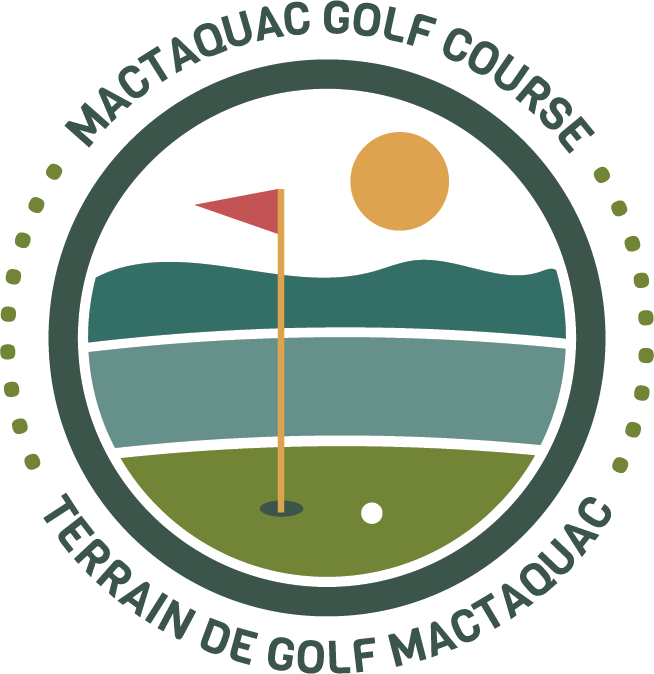
Mactaquac Golf
1265 NB-105 Mactaquac
Front Nine
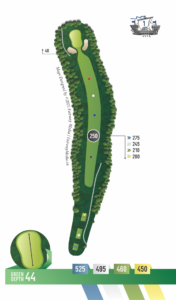 Hole 1
Hole 1
Length: 525 yards (blue tee); 495 yards (white tee); 450 yards (yellow tee).
Par: 5
Handicap rating: 3
A straightaway shot off the tee with trees bracketing the fairway on either side, the most difficult aspect of the tee shot is the illusion of a narrow fairway punctuated by most golfers not being properly warmed up. As a result, the woods on the right side tend to be a favorite landing area for the mid to high handicapper.
Ideal landing area off the tee is towards the right side of the fairway, giving the golfer a better look towards the green, which is a slight dogleg to the left. Only the longest of hitters can contemplate getting on in two and only those shots to the right have a good enough angle. Balls to the left take away any possibility of getting on in two even for the best of players.
There’s ample landing area leading up to the green with again, right center being the most favorable location from which to hit an approach shot to the green. Golfers need to be wary of a thick rough bordering tree line on the right.
Most mid-handicappers with two reasonable shots are usually faced with a wedge or high iron on their approach to the green, which is surrounded by traps to the left and front right. There are trees on either side all the way down the fairway and near the green with right long being the most deadly location.
Most difficult pin placement is right front, behind the right trap, making approach shots from the right side to that location impossible to get close. Slope of the green is back to front with the right side being the most severe. Realistic birdie hole as par-fives go and a relatively easy hole for the better golfers to at least get par.
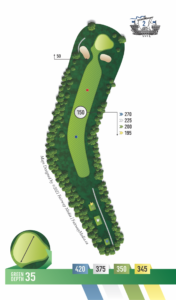 Hole 2
Hole 2
Length: 420 yards (blue tees); 375 yards (white tees); 345 (yellow tees)
Par: 4
Handicap rating: 11
Tricky par four to a dogleg right green. Tee-shots towards the left have a tendency to kick into the woods with the fairway sloping in that direction and with the tree line jutting out at about a 45-degree angle at the 200-yard mark.
As a result, the longer hitters will try to draw the ball over the trees bordering the right side looking to land the ball on the left side of the fairway which presents the better angle to the green. Danger is pushing the ball right, guaranteeing a spot in the woods and virtually making par impossible.
The shorter hitters can afford to aim left center with plenty of room although any ball landing on the right side of the fairway presents a challenging shot to a green, which is protected front-center and right by a huge gaping trap. There’s also a trap bordering the left side of the green that gets plenty of attention with golfers trying so hard to avoid the right side. A particularly dangerous location is long left beyond the trap into deep grass, which makes a lost ball a realistic possibility. There’s plenty of room to the right of the green and that’s the normal bailout area for golfers who fail to get on in regulation and are able to avoid the front right bunker.
Relatively flat green with the most difficult pin placement being front right and long left. Tough hole to make birdie. Oddly enough, golfers tend to either par the hole or make double bogey with the approach shot being the key shot.
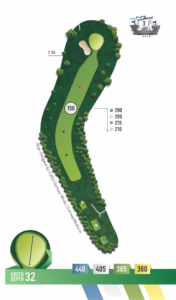 Hole 3
Hole 3
Length: 440 yards (blue tees); 405 yards (white tees); 360 yards (yellow tees)
Par: 4
Handicap rating: 1
Relative to making par, this is arguably the toughest hole on the entire golf course, witness the handicap rating. More often that not, the wind factor is a compelling aspect of playing the hole, normally leaving even the longest of hitters with a long iron to a green that is protected by a huge bunker front left.
Trees bordering the entire left side of the fairway aren’t really a factor but a line of trees that jut out from the right side tend to gather plenty of balls, particularly if the wind is blowing harder than normal. Balls strayed to the right if hit far enough will find another patch of trees running at a 90-degree angle to the clump of trees at the right corner.
Ideal tee-off shot is right-center, giving you a direct approach to a dogleg right green. Balls hit to the left edge of the fairway require a longer shot into the green over a huge trap protecting front left side. Considerable rough, all the way up the left-hand side, making the shot over the trap even more difficult. Right side bail-out at least allows the golfer chance to get up and down without having a trap to play over even though there is considerable rough on that side as well. Trees well right of the green shouldn’t be a factor.
Toughest pin placement on a large green is back left with considerable slope from top left to front right. Front left pin placement can be tricky as well. Par is considered a very good score, particularly with the length of second shot requiring pinpoint accuracy and maybe a break or two.
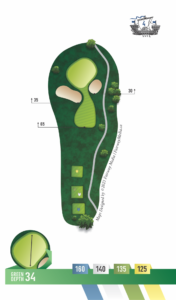 Hole 4
Hole 4
Length: 160 yards (blue tees); 140 yards (white tees); 125 yards (yellow tees)
Par: 3
Handicap rating: 17
The first of four par-threes, the most compelling aspect of the tee-shot are the two traps protecting the green, one front left and the other to the right. Little slope in front of green tends to direct balls into the right trap so hitting the green with the tee-shot is a key. Depending on the wind factor, golfers faced with anywhere from a low iron to eight or nine iron. Left trap is particularly nasty because it’s deeper and more angled than right trap although normal pin placement is to right side of the green, making for a tricky shot out of the right trap with little green to work with. Trees right of the right trap and close enough to come into play if ball rolls off back right and hits the slope.
Toughest pin placement is left front with most severe slope from back left to back right. Putts from left side will move substantially from left to right as they get near the hole, making for an easy three-putt. Putts from above the hole back right, particularly nasty.
Depending on where the pin is, possible birdie hole with par a realistic score for most golfers.
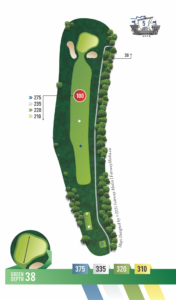 Hole 5
Hole 5
Length: 375 yards (blue tees); 335 yards (white tees); 310 yards (yellow tees)
Par: 4
Handicap rating: 13
Fairly straight tee shot with out of bounds to the left and trees to the right. Best angle into a slightly dogleg right green is left center of fairway, avoiding having to clear a nasty trap protecting front right side of the green. Trap left of the green as well but one of the easier bunkers from which to play.
Shots hit left of fairway off the tee will find considerable rough and tricky slopes from which to hit approach shots to the green. Shots to the right side of course bring front right trap into play. Trees well right of the green can come into play because of hard ground which tends to push shots off to the right. Water in behind the hole but so far back that it rarely if ever comes into play. A decent tee shot allows for a nine or wedge on the approach.
Front right of green has considerable slope pushing balls from front right to back left. That makes playing out of right trap even more difficult. Toughest pin placement is front-right with front-left also making for a tricky putt. But a definite birdie hole for most players.
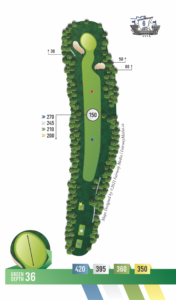 Hole 6
Hole 6
Length: 420 yards (blue tees); 395 yards (white tees); 350 yards (yellow tees).
Par: 4
Handicap rating: 9
Again, a straightaway hole with woods bracketing fairway both to the left and right sides. With tee area more to the left, any shots to the left side likely to find tree trouble particularly with the slope of the ground directing balls in that direction as well. Woods on the right also gets plenty of play although extremely wayward shots to the right will find the fifth hole fairway, allowing for a shot over a line of trees back towards the sixth green. Big tree located right center of fairway about 240 yards from the tee and that, combined with rough on the right side, can make for a tricky approach shot to the green.
Ideal landing area off the tee is left center and that leaves a high iron for an approach to a green that is protected on the left side by a bunker with a fairway bunker about 30 yards short of the green on the right side. Woods can come into play with shots going left of the green over the left trap or for particularly wayward shots to the right side. Considerable rough to right of green makes for a tricky shot onto the putting surface.
Most difficult pin placement is back right with severe slope from back left towards front left. Another tricky pin placement is just over the left hand trap with a left to right slope by the hole. With the fairway appearing narrower than it actually is off the tee, hole can look intimidating. Not a birdie hole by any means.
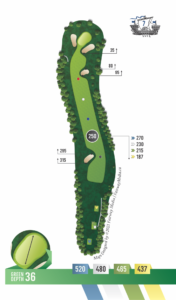 Hole 7
Hole 7
Length: 520 yards (blue tees); 480 yards (white tees); 437 yards (yellow tees)
Par: 5
Handicap rating: 5
The second of the par fives that plays straight out from the tee with a fairway trap about 200 yards protecting left front of the fairway. The better golfers have no problem playing over the trap but anything too far left will find the trees that are about 240 yards off the tee. Trees all the way up the right side tend to get plenty of play from mid-handicappers looking to avoid first fairway bunker. Also, balls hit right of the center will find considerable rough all the way down to the green.
Long hitters can easily reach the green in two with no more than a mid-iron although the slightly dogleg right green is well protected by a deep bunker to the left, a fairway trap about 50 yards short of the green right center and another trap protecting the front right of the green. A patch of trees is not far off the green to the right although they shouldn’t come into play. Trees well left no factor except for badly pulled shots.
For those looking to run the ball up onto the green, there’s a severe left to right slope tending to push balls towards the right trap. The left trap is also very prominent, making for a precise second shot if that be the golfer’s desire. Those taking a more conservative route tend to play left of the fairway trap with their second shot, leaving themselves a relatively easy chip shot onto the green.
Toughest pin placement on one of the faster greens is front right just behind the front right trap. Left front can also be tricky with the slope of the green pushing balls towards the front left edge. Definite birdie hole, with eagle possibilities for the better golfers. Should be routine par for most other golfers.
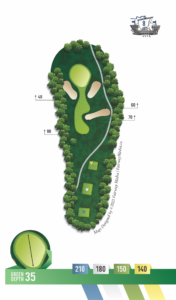 Hole 8
Hole 8
Length: 210 yards (blue tees); 180 yards (white tees); 140 yards (yellow tees)
Par: 3
Handicap rating: 15
Deceptive par three that tends to play a little longer than it measures. With the green angled slightly to the left, golfers tend to push their tee shots into a huge front right trap guarding the entire right side. Front left trap also gets plenty of play because of golfers over compensating for the angle. There are trees on both sides of the green, with the right side tending to attract more balls. Fairway trap no factor except for the worst of hit tee-shots.
Toughest pin placement on a large green is back left because of tricky left to right slope that looks more severe than actually exists. Also front right makes for a challenging putt because of the back to front slope of the green. Most golfers need to hit more club than the yardage to clear the traps, making for some confusion. But birdie a definite possibility with a good tee shot. Par should be fairly routine for most golfers.
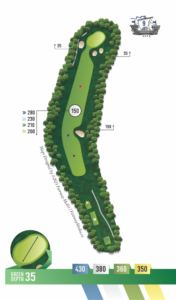 Hole 9
Hole 9
Length: 430 yards (blue tees); 380 yards (white tees); 350 yards (yellow tees).
Par: 4
Handicap rating: 7
One of the more aesthetically pleasing holes on the entire golf course, the most compelling aspect of the ninth hole is the approach shot onto a green protected by a huge and deep bunker front right and a bunker to the left. Setting up the approach is a tee-shot that needs to be on the left center of the fairway to avoid hitting from an awkward lie anywhere on the right side of the fairway.
Fairway trap center right about 230 yards off the tee can be a factor when the wind is blowing against the golfer, otherwise, most mid to low handicappers able to clear the right bunker. Perfect shot is a little draw over fairway bunker. Trees to the right of the fairway bunker get plenty of play while left side tree-line juts out at about a 45-degree angle at about the 250-yard mark off the tee. Trees surround the green with those on the right side particularly dangerous because of a severe fairway slope pushing balls in their direction.
Front right trap most severe of any on the golf course and depending on the pin placement, balls finding the lower portion of the trap result in a blind shot for the golfer hitting onto the green. Left trap nowhere near as difficult. Toughest pin placement is back left because of a severe left to right slope. Definite three-putt potential if you are not careful. Putts front left can be tricky as well with the slope angling towards the front of the green. Most golfers consider par a good score.
Back Nine
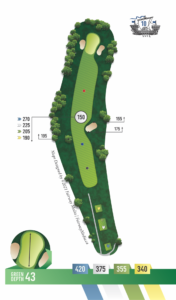 Hole 10
Hole 10
Length: 420 yards (blue tees); 375 yards (white tees); 340 yards (yellow tees)
Par: 4
Handicap rating: 14
Fairly easy starting point for the back nine although the wind always tends to be a factor here. Fairway trap center right tends to get plenty of play with a huge tree jutting out from the left side of the fairway. Line of trees to the right although most golfers should be able to clear those with any kind of decent tee-shot. Shots to the right side will find plenty of rough and a smattering of trees that will make for a difficult approach to the green.
Ideal tee-shot is left center beyond the fairway trap, allowing for a high iron for the approach shot to a green protected to the left and right by bunkers. Left hand bunker particularly nasty if pin placement is upper left hand portion of the green because of a severe slope from back left towards right front. Trees behind the green tend to come into play as well. Trees to the right of right trap not much of a factor.
Green itself is as severe as any on the golf course with back left and front left the most difficult pin placements. Slope of the green puts premium on accuracy with the approach shot. Tough green makes birdie a difficult accomplishment. But should be a relatively easy par for most mid to low handicappers.
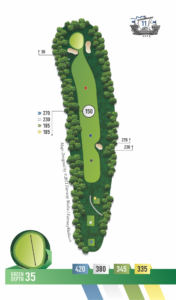 Hole 11
Hole 11
Length: 420 yards (blue tees); 380 yards (white tees); 335 yards (yellow tees)
Par: 4
Handicap rating: 10
One of the more interesting par-fours on the entire layout because of the tee-shot that is one of the most difficult. With a fairway trap center right, the ideal tee-shot is a slight draw over the center portion of the trap that will make its way down the left side of the fairway sloping down and leaving a high iron approach shot to the green. Tee shots slightly to the left will find woods and because of that, golfers tend to push the ball to the right side where there are trees as well. Furthermore, the fairway has a fairly severe slope left to right pushing balls into deep rough, which begins at about the center right portion of the fairway just beyond the fairway trap.
Trees protect the left side all the way to the green, which is a slight dogleg to the right. Protecting the front left of the green is a trap that tends to get plenty of play. There’s also a trap right of the green that can prove troublesome for golfers trying to run the ball up onto the green just to the right of the left front trap. That’s because the slope of the fairway goes from left to right and right into the right trap.
Most difficult pin placement is back left where there is a severe slope from the left to right side of the green. Golfers forced to putt from the right back to a back left placement are virtually guaranteed to three-putt. Same with putts from above the hole. Shots finding their way into the rough beyond the left front trap make for perhaps the most delicate of chip shots on the entire golf course. Par is definitely a good score.
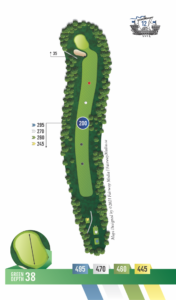 Hole 12
Hole 12
Length: 495 yards (blue tees); 470 yards (white tees); 445 yards (yellow tees).
Par: 5
Handicap rating: 4
Another aesthetically pleasing hole, golfers looking to find the green in two must drive the ball to the right side of the fairway. Anything left will filter down towards the deep rough if not into the woods, which are a definite concern all the way down the left side of the fairway. Woods to the right side as well although there’s an open spot about 230 yards off the tee that allows for players to have a pretty good angle towards a green that is a dogleg left.
The longer hitters finding the right side can get on with a mid-iron although they had best beware of a gaping trap protecting the entire front left portion of the green. Save for the ninth hole, the left trap at 12 presents the most severe sloping bunker shot for the player.
Players taking a more conservative approach aim to hit their second shots to the right over a hill, leaving for a relatively easy pitch shot to the green. Too far right and golfers will be forced to hit balls out of pretty severe rough, increasing their margin of error.
One of the more sloped greens on the course, most difficult pin placements are back right and front left just over the left trap. Back right is tricky because of a severe right to left slope that makes three putts a distinct possibility. Front left slopes from left to right. Definite birdie hole.
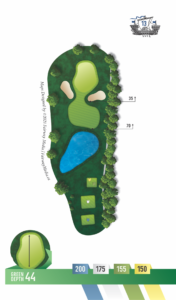 Hole 13
Hole 13
Length: 200 (blue tees); 175 yards (white tees); 150 yards (yellow tees)
Par: 3
Handicap rating: 16
Like No. eight, the par-three 13th tends to play a little longer than it looks, particularly with a gaping trap protecting the entire front right of the green. Trap to the left not as big a concern for most golfers. Water hazard crisscrossing fairway but of no factor except for balls dribbling off the tee. Trees to the right side shouldn’t be a factor although balls pushed in that direction will tend to hit hard cart path and jump into the woods. Most compelling aspect of the hole is the front right trap that almost always makes for a long bunker shot.
Toughest pin placements on one of the bigger greens on the course are back right and back left. Slope from right to left actually more severe than it looks. Three putts definite possibility because of the huge green. Three considered a good score.
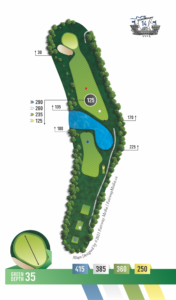 Hole 14
Hole 14
Length: 415 (blue tees); 385 yards (white tees); 350 yards (yellow tees)
Par: 4
Handicap rating: 2
Relative to making par, arguably the most difficult of the par-fours because of a water hazard crisscrossing the fairway about 200 yards off the tee and extending for another 20 to 25 yards across depending on which side of the hazard you’re trying to cross.
The longer hitters will attempt to blast over the water, looking to find the right center portion of the fairway that will give them an easy high iron approach to the green, but for the mid to high handicapper, too risky to play over the water. So the play is hitting an iron to the water and trying to hit a low iron approach shot to the green protected front left by a trap. With the hard ground, iron shots off the tee hitting the right side of the fairway will tend to roll into the drink. As well, it presents an even longer approach shot from the right side.
Trees well left shouldn’t come into play near the green although there are trees to the right that tend to get plenty of play, particularly with shots originating from behind the water on the right side. Toughest pin placement on a relatively flat green is front left with the slope going from left to right. With the perils presented by the water hazard off the tee, par is definitely a good score.
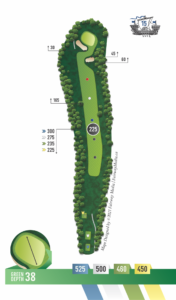 Hole 15
Hole 15
Length: 525 yards (blue tees); 500 yards (white tees); 450 yards (yellow tees)
Par: 5
Handicap rating: 6
The longest of the par-fives but a fairly straightaway drive allows for the longer hitters to contemplate getting on in two shots albeit the danger areas lurking about the green.
Ideal landing area off the tee is left center allowing for a better angle to the green that is protected by a fairway bunker about 20 yards short of the green center right and a gaping bunker protecting the left front portion of the green. There are trees bracketing the fairway on either side with the golfer more likely to hit the ball into the left trees off the tee. For the more conservative player, ideal second shot is behind the fairway trap to the right side, leaving for a clear high iron approach to the green. Shots winding up on the left hand side of the fairway present a troublesome approach shot over the gaping left center trap which guards about two-thirds of the green. Bail-out area is to the right beyond the fairway trap but not much room before finding tree trouble on the right side as well.
One of the most severely sloped greens on the course, there are several difficult pin placements placing a premium on accuracy with the approach shot. Most difficult pin placements are front right, back left and back right, all presenting anxious moments for even the steadiest of putters. Definite three-putt potential on this green. Definite birdie hole but only if the approach shot winds up on the low side of the hole. Otherwise, par is a good score.
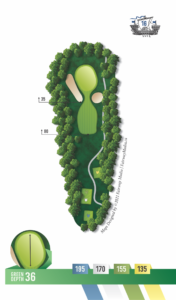 Hole 16
Hole 16
Length: 195 yards (blue tees); 170 yards (white tees); 135 yards (yellow tees).
Par: 3
Handicap rating: 18
Considered the easiest of the par-threes, most golfers can reach the green using a high iron although there is danger front center with a trap and to the left with a trap ready to accept wayward shots. Trees behind the green can come into play if golfer misjudges the wind and uses too much club. Fairly flat green with the most difficult pin placement being front right behind the trap. Slight slope from back to front. But most golfers feel comfortable putting on this green, even with the longer putts and thus, tend to make more long putts for birdie. The most likely birdie hole among the par-threes.
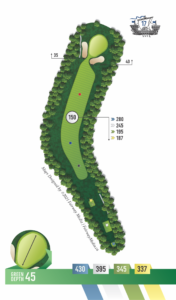 Hole 17
Hole 17
Length: 430 yards (blue tees); 395 yards (white tees); 337 yards (yellow tees)
Par: 4
Handicap rating: 8
Considered the signature hole at Mactaquac, the most compelling aspect is the delicate tee-shot with trees a definite problem on the left and to the right. The longer hitters will try to draw the ball over the trees on the right looking to land the ball on the high side of the fairway which slopes from right to left into some rather nasty rough. Balls off the tee going left are trouble because the tree-line juts out at about a 45 degree angle at the 180-yard point. Ideal landing point is left center, leaving for a mid-iron approach shot up the hill towards a slightly elevated green.
A fairly substantial trap protects a large and two-tier green right front with a trap on the left not as compelling although it does tend to generate plenty of activity. Toughest pin placements are back left because golfers putting from the right have to negotiate a ridge and front left with a severe right to left slope. With the precarious tee shot, par is considered a good score.
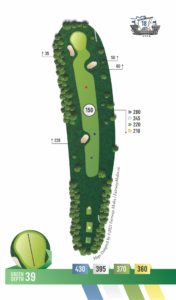 Hole 18
Hole 18
Length: 430 yards (blue tees); 395 yards (white tees); 360 yards (yellow tees)
Par: 4
Handicap rating: 12
A straightaway finishing hole that plays longer than the distance because of an uphill slope to the fairway. Fairway trap center left a definite concern especially off the back tees and if the wind happens to be against the golfer. Wayward tee shots left end up in long grass with nary any chance of getting out. Trees to the right side don’t usually come into play although balls to the right will tend to find some nasty rough.
Ideal drive is left center just beyond the fairway trap, leaving for a mid-iron approach to an elevated green protected on the left side by a bunker and a fairway bunker situated right center about 30 yards short of the green. Bail-out area is to the right although rough can provide for a challenging chip shot. One of the easiest greens on which to putt, the toughest pin placements are back left with a left to right slope and front right. A nice finishing hole with definite birdie possibilities but it requires two solid shots. Par is always a nice way to finish up.
